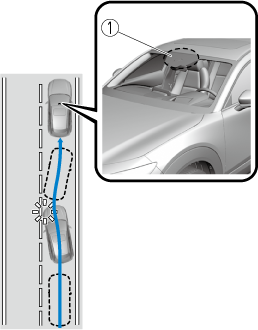

Lane Departure Warning System (LDWS)
The LDWS alerts the driver that the vehicle may be deviating from its lane. The system detects the white (yellow) lines on the traffic lane using the forward sensing camera (FSC) and if it determines that the vehicle might be deviating from its lane, it notifies the driver by the LDWS.
Refer to Forward Sensing Camera (FSC) (Search).
Use the LDWS when you drive the vehicle on roads with white (yellow) lines.

-
Forward sensing camera (FSC)
Do not rely completely on the LDWS:
-
The LDWS system is not designed to compensate for a driver’s lack of caution and relying too much on the system could lead to an accident.
-
The functions of the LDWS have limitations. Always stay on course using the steering wheel and drive with care.
Heed the following cautions so that the LDWS can operate normally.
-
Do not modify the vehicle's suspensions.
-
Always use tires of the specified type and size for the front and rear wheels. Consult an Authorized Mazda Dealer for tire replacement.
The system may not operate normally under the following conditions.
-
The white (yellow) lane lines are less visible because of dirt or paint flaking.
-
White (yellow) lane lines are less visible because of bad weather (rain, fog, or snow).
-
The vehicle is driven on a temporary lane or section with a closed lane resulting from construction where there might be multiple white (yellow) lane lines, or they are interrupted.
-
The camera picks up an obscure line, such as a temporary line being used for construction, or because of shade, unmelted snow, or grooves filled with water.
-
The surrounding brightness suddenly changes such as when entering or exiting a tunnel.
-
Back-light is reflected off the road surface.
-
The road surface is wet and shiny after rain, or there are puddles on the road.
-
The width of a lane is excessively narrow.
-
The vehicle is driven on roads with tight curves.
-
Heavy luggage is loaded in the luggage compartment or on the rear seat causing the vehicle to tilt.
-
The vehicle is driven through a fork in the road or a junction.
-
The shade of a guardrail parallel to a white (yellow) lane line is cast on the road.
-
The illumination of the headlights is weakened because of dirt or the optical axis is deviated at night.
-
The road is excessively uneven.
-
The vehicle is shaken after hitting a road bump.
-
A vehicle in front of your vehicle is running near a white (yellow) lane line making it less visible.
-
The windshield is dirty or foggy.
-
Strong light is directed from the front of the vehicle (such as sunlight, or headlights (high-beam) of on-coming vehicles).
-
The vehicle is driven through an intersection or a roundabout.


